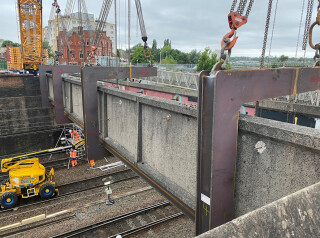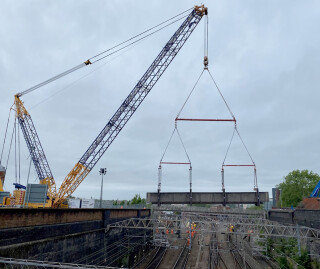There’s one major headache for anybody tasked with removing a railway footbridge: everything below it.
When contractor J Murphy & Sons was given the job of demolishing a 60-year-old concrete footbridge over the main railway line into Stockport, Manchester, the client – Network Rail – made it clear that it needed to be done quickly and with minimal disruption to rail services.
The bridge, about 26m long and weighing 92 tonnes, was in very poor condition and it would not have taken much to bring it down. But although in situ demolition is the traditional solution, it would have taken a long time and involved protracted closure of the railway line running underneath.
This article was first published in the September 2020 issue of The Construction Index magazine. Sign up online.
Murphy thought a better solution would be to lift the entire bridge out intact and demolish it away from the railway line. For this, it contacted specialist supplier Lifting Gear UK for a solution.
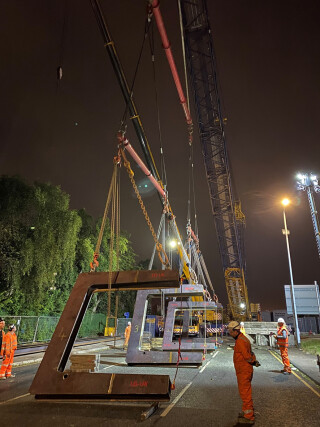
“What they’d normally do is take all the catenary equipment [such as overhead power lines] down and lay everything on the tracks. Then they’d put some protection over them and then a layer of sand with timber mats over the tracks and the cables,” explains Chris Turner, operations director with Lifting Gear UK.
“Then they’d munch the bridge up, drop it onto the tracks, take it away, clean everything up and replace all the catenary again,” he adds.
“This bridge was quite long and there was a lot of concrete there – they’d have been nigh on a week removing everything and getting the line open again. God only knows how much that would have cost them”.
Turner got together with the Murphy team and soon devised a method which would allow them to lift the bridge off its bearings intact.
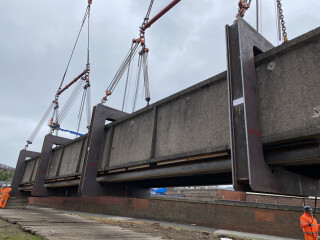
The solution was a variation on a familiar concept – the C-hook. Commonly used in industry for transporting loads such as coils of steel and other heavy, bulky items, a C-hook wraps around the load, lifting it securely from below.
A more familiar example of the concept for those in the construction industry is the ubiquitous crane pallet fork, used to lift bricks, blocks and other heavy palleted goods. But the type of C-hook required for this job didn’t currently exist.
Luckily, Lifting Gear UK has a subsidiary, Steelwise, that specialises in the production of bespoke steel fabrications – so the design and manufacture of these hooks was easily accomplished.
To lift the bridge, Lifting Gear UK required four C-hooks suspended from the company’s own modular spreader beams. “The challenge for Steelwise was making C-hooks work on a much bigger scale,” says Turner.
Steelwise technical manager Alastair Clark and design engineer Will Almond designed, fabricated and tested the new C-hooks before deploying them on site.
Each hook weighs 3.5 tonnes and is capable of lifting up to 25 tonnes. In order to lift the bridge without inducing any stresses in it, Lifting Gear UK bolted two 26m support beams to the hooks. This provided complete support for the full length of the footbridge, which was pre-tensioned and very fragile.
The lifting operation was completed overnight in May, using an 800-tonne capacity Demag TC2800 lattice-boom crane supplied by Ainscough. Chain blocks were used to link the spreader beams to the C-hooks and provide fine adjustment, as Turner explains:

“When you rig the load up, the centre of gravity on each hook is in a different place, so when you start hoisting the load, you have to adjust the chain blocks to transfer the centre of gravity to the centre of the bridge. We couldn’t have done it without this.”
Using C-hooks (rather than simply running steel beams underneath the and connecting slings to each end) ensured a stable load. The C-hooks were also easy to slip underneath the bridge without fouling the overhead power lines which ran just 500mm to 600mm below.
The lift was designed so that the load was rotated slightly, with one side of the bridge raised about 300mm before the other side started to move. This helped to ensure the bridge was free of its bearings before being lifted clear.
“To actually assemble all the lifting tackle, then lift the bridge out and then put it all back on the floor took 14 hours,” says Turner. “If they’d gone the traditional route and dropped the bridge, I’d say it would have taken about five days, working around the clock.
“Network Rail saved themselves a fortune,” he declares.
The client certainly seems pleased with the result. “When we were finished on this job, Network Rail came to me and said ‘we need to speak to you more in the future, because the way we did this bridge brings us back on programme really fast and it’s a lot safer’,” reports Turner.
Turner is confident that this novel solution will prove popular for bridge removals and hints at an even bigger job in the offing, requiring even larger C-hooks.
“I’ve got an idea in my head that instead of having an open end on one side, you’d have a pennant bar coming down on a ram so once you’d fished it underneath the bridge you’d have your bar come down to make it like a box – and double the strength of the hook,” he says.
Meanwhile, Turner is already in talks with Murphy about another bridge removal – a smaller one requiring only two of the new C-hooks this time. “So yes, they’re here in our yard sitting nice and pretty and ready to go out again,” he says.
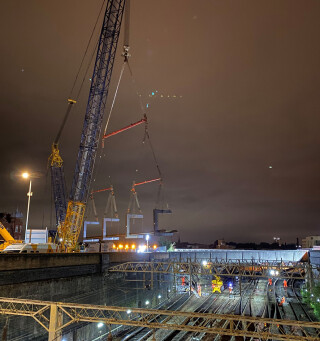
This article was first published in the September 2020 issue of The Construction Index magazine. Sign up online.
It’s all about the tackle
With headquarters in Skelmersdale, Lancashire, Lifting Gear UK was founded in 2007 specifically to address what Chris Turner believed was a neglected aspect of heavy lifting: below-the-hook equipment.
“We set up Lifting Gear UK because we saw a bit of a niche market: everybody used to think about getting the crane on hire and paid-for but nobody thought about the lifting tackle,” says Turner, who spent 20 years with Ainscough as a crane operator and, latterly, lift-planner.
His company offers a wide range of components, many of them designed and built in-house. “We have our own range of modular beams up to 130 tonnes,” says Turner. He estimates that Lifting Gear UK’s 10 regional depots probably have over 1,000 modular beams capable of lifting loads from 10 tonnes to 900 tonnes.
The company now comprises four divisions: in addition to the hire and sale of lifting tackle and associated equipment there’s Lifting Gear Projects UK, which plans and manages lifts as well as providing equipment; Steelwise to design and build bespoke components like the C-hook; and a training division, Lifting Gear Training UK.
A lot of the company’s work is carried out in partnership with the UK’s leading crane hirers. “We have good relationships with all the big crane hirers because we have a vast amount of lifting equipment that they don’t have. Heavy lifting is a small world – everybody knows each other,” says Turner.
This article was first published in the September 2020 issue of The Construction Index magazine. Sign up online.
Got a story? Email news@theconstructionindex.co.uk

